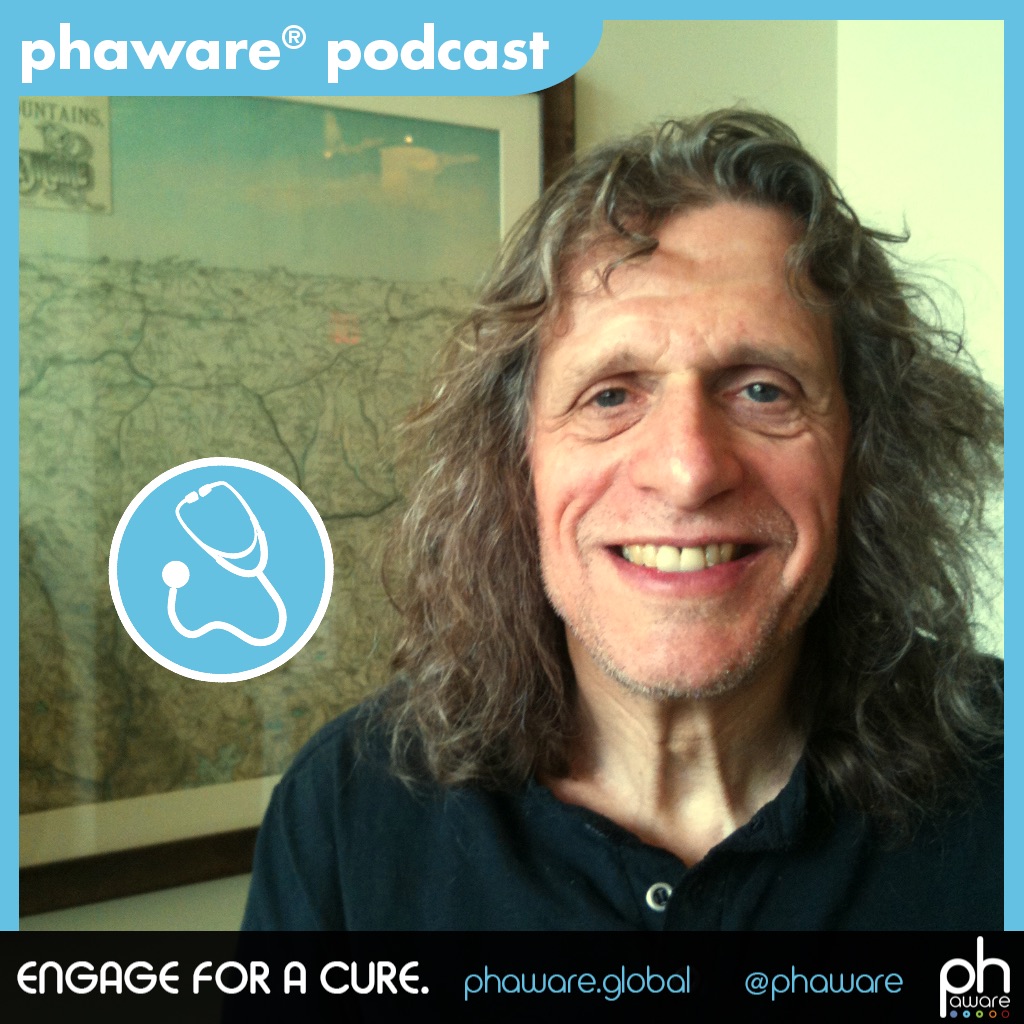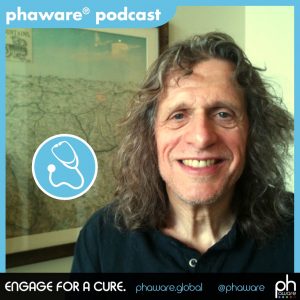Phaware Podcast: Harrison ‘Hap’ Farber, MD (Part 1 of 2)

This podcast series, created and produced by phaware, is being offered as a regular guest feature on Pulmonary Hypertension News to bring the voices and life experiences of PH patients, family members, caregivers, healthcare specialists, and others to our readers. You may listen to the podcast directly, or read it via the transcript that runs below.
I’m Aware That I’m Rare: Harrison “Hap” Farber, MD
The phaware® interview (Episode 119)
Harrison “Hap” Farber, MD discusses inhaled iNO (nitric oxide) and oxygen therapy as an add-on therapy for patients with pulmonary hypertension.
Dr. Farber is considered an opinion leader and internationally recognized expert in the field of pulmonary hypertension. He is a professor in the Department of Medicine and attends in the Medical Intensive Care Unit and on the Pulmonary Consultation Service at Boston Medical Center. He also oversees the care of all patients with pulmonary hypertension at Boston Medical Center.
I’m Hap Farber from Boston University School of Medicine at Boston, and we’re going to talk about inhaled iNO and oxygen therapy.
So, there’s a study going on that looks at inhaled iNO as an add-on therapy for pulmonary hypertension, PAH, and the early Phase 2 [clinical] studies have shown that, depending on the dose, and we’re going to talk about the higher dose, the 75 (iNO dosed at 75 mcg/kg IBW per hour), is the fact that the more you use it, the better the response, so that the people who used it more than 12 hours a day had a much better response as measured by hemodynamics and functional capacity six-minute walk than those that didn’t. And it turns out, in retrospect, when you went back and looked at the data, the people who used it the most were the people who were also on supplemental oxygen.
hypertension, PAH, and the early Phase 2 [clinical] studies have shown that, depending on the dose, and we’re going to talk about the higher dose, the 75 (iNO dosed at 75 mcg/kg IBW per hour), is the fact that the more you use it, the better the response, so that the people who used it more than 12 hours a day had a much better response as measured by hemodynamics and functional capacity six-minute walk than those that didn’t. And it turns out, in retrospect, when you went back and looked at the data, the people who used it the most were the people who were also on supplemental oxygen.
If you think about it, that does make sense because most people are sort of self-conscious about having a tube running out of their nose, but if they’ve already accepted the fact that they’re on supplemental oxygen, then adding this is really no big deal because it can be piped into the oxygen, so you only have one tubing.
In the future study, the study that’s going on now, the Phase 3 trial, in that it is restricted to people who are on supplemental oxygen, therefore those people will use it probably most of the day, if not even 24 hours, and you would expect that the best response that you’re going to get would be with those people.
Now, you can argue that this is a small subset of patients who have PAH, those who use supplemental oxygen. But it turns out that that may not be the case because there is data looking at the patient population from the REVEAL Registry, which is 3,500 patients, that about 30% to 40% of them have used or are using oxygen when they were in the registry, which was a five-year registry of patients with PAH. So, although it’s not all patients with PAH, it is a substantial proportion of those with PAH who do use supplemental oxygen.
So, assuming that this were a positive study, then this is another potential agent for treatment in people who are already on background therapy. It is not, and nor will it be, studied in people who are treatment-naive. This is strictly for add-on therapy for patients who are, however you want to call it, not doing as well as either they or you would expect on the medications that they’re on.
Supplemental oxygen does several things. One, it dilates your pulmonary circulation, but it also, obviously, supplements your oxygen if you’re not getting enough. Inhaled nitric oxide also dilates your pulmonary circulation. Whether the two do anything that’s additive is probably not known. But the major point is that whether they are supplemental to each other or whether they do anything in addition to each other is sort of irrelevant. What it’s really important for is if you are on oxygen, that means you already have a cannula in your nose, and you are hooked up and you’re used to machines, therefore accepting, if you will, inhaled nitric oxide, then, is not as much of a big deal as people who have never had this before.
There are short-term studies and a couple of case reports in the literature from long-term studies of people getting benefit for inhaled iNO. I mean, after all, it is the preferred agent for vasodilator testing in PAH. If you are going to do that, because it is acutely well-vasodilative. I think we’ve all known for years that inhaled iNO will dilate you. The problem is very simple. The gas has such a short half-life that getting people to use it has been difficult, but once again, it’s this issue of, if you’re already used to supplemental oxygen and having a tube in your nose, well, then doing this is not a big deal.
I’m Hap Farber, and I’m Aware That I’m Rare … (Other people have said that, usually cynically.)
EVERYBODY HAS A STORY. WHAT’S YOURS?
Phaware global association wants to share your pulmonary hypertension story with their engaged global audience. Whether you are a patient, caregiver, or medical professional, they are enlisting PH community members from around the world. Visit www.phawarepodcast.libsyn.com/contact to share your story and to be considered for a future episode. Never miss an episode with the phaware® podcast app. Learn more about pulmonary hypertension at www.phaware.global. #phaware
Note: Pulmonary Hypertension News is strictly a news and information website about the disease. It does not provide medical advice, diagnosis, or treatment. This content is not intended to be a substitute for professional medical advice, diagnosis, or treatment. Always seek the advice of your physician or other qualified health provider with any questions you may have regarding a medical condition. Never disregard professional medical advice or delay in seeking it because of something you have read on this website. The opinions expressed in this column are not those of Pulmonary Hypertension News or its parent company, Bionews Services, and are intended to spark discussion about issues pertaining to pulmonary hypertension.










Leave a comment
Fill in the required fields to post. Your email address will not be published.